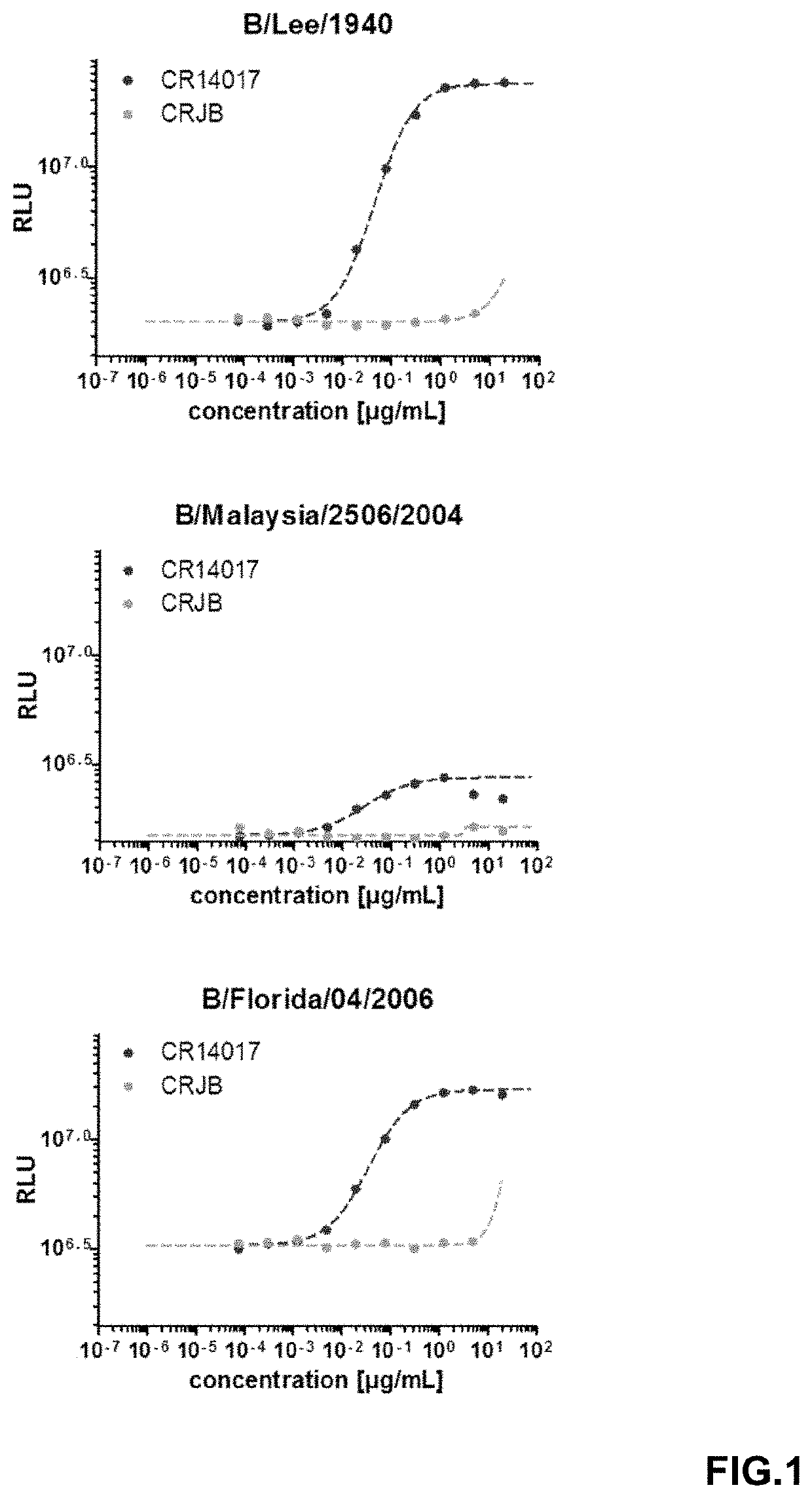Human neutralizing antibodies binding to influenza b neuraminidase
a technology of human neutralizing antibodies and influenza b, applied in the field of medicine, can solve the problems of extensive burden on health care costs and productivity loss
- Summary
- Abstract
- Description
- Claims
- Application Information
AI Technical Summary
Benefits of technology
Problems solved by technology
Method used
Image
Examples
example 1
d Binding Assay
[0086]Binding features of the anti-NA antibodies were assessed by testing their reactivity to NA-expressing cells by flow cytometry. FreeStyle™ 293-F cells (Invitrogen™) were transfected with plasmid containing the NA-encoding gene of choice using 293fectin™ (Invitrogen™). Constructs containing the NA gene from the following viruses were used: B / Yamagata / 16 / 88 (Yamagata lineage) B / Brisbane / 60 / 08 (Victoria lineage), B / Lee / 40 (the first isolated influenza B virus), B / Wisconsin / 01 / 10 (Yamagata lineage) and H5N1 A / Hong Kong / 156 / 97.
[0087]For a 30 ml transfection suspension, 30 μg of plasmid DNA and 40 μl of 293fectin™ were separately diluted in Opti-MEM® I (Gibco®) to a total volume of 1 ml. After 5 min incubation, the diluted DNA was added to the diluted 293fectin™ to obtain a total volume of 2 ml that was incubated for 20-30 min at room temperature to allow the DNA-293fectin™ complexes to form. Two ml of DNA-293fectin™ complex were added to 28 ml cell suspension containi...
example 2
dase Inhibition Assay
[0091]The ability of anti-NA antibodies of the invention to inhibit neuraminidase activity of influenza viruses was assessed using the NA-XTD™ Influenza Neuraminidase Assay Kit (Applied Biosystems / Life Technologies) following the manufacturer's specifications with minor adjustments. For each influenza strain, serial dilutions of the virus stock were tested to determine the virus dilution resulting in a chemoluminescent signal of 105 RLU. Antibodies were serially four-fold diluted (40-0.0002 μg / ml) in NA-XTD™ assay buffer containing 0.1% asialofetuin (Sigma Aldrich). From each dilution, 25 μl was transferred to a NA-Star™ Detection Microplate and mixed with 25 μl diluted virus. The plate was incubated at 37° C., 10% CO2 for 20 min before adding 25 μL / well of the NA-XTD™ Substrate (diluted in NA-XTD™ assay buffer containing 0.1% asialofetuin). Subsequently, the plate was incubated at room temperature and in the dark for 20-30 min, after which 60 μl NA-XTD™ Acceler...
example 3
tralization Assay
[0094]To determine whether the anti-NA antibodies are capable of neutralizing type B influenza virus infection in vitro, virus neutralization assays (VNA) were performed with the following viruses: B / Brisbane / 60 / 2008 (Victoria lineage), B / Florida / 04 / 2006 (Yamagata lineage), B / Malaysia / 2506 / 2004 (Victoria lineage), B / Lee / 1940. To this end, 96-well plates were coated with 4×104 MDCK-SIAT1 cells (Sigma Aldrich) per well in infection medium containing 3 μg / ml trypsin. Antibodies, including controls, were two-fold serially diluted in plain medium containing L-glutamine, in a 96-well plate. The virus was diluted to a titer of 5.7×103 TCID50 / ml with double infection medium (plain medium +L-glutamine containing 6 μg / ml trypsin) and added at a 1:1 ratio to the antibody-dilution containing plate, resulting in a final amount of 2.85×103 TCID50 / ml of virus. The plate was subsequently incubated for 1.5-2 h at 37° C., 10% CO2 before infecting 100 μl / well MDCK cells by adding 35 μ...
PUM
| Property | Measurement | Unit |
|---|---|---|
| Length | aaaaa | aaaaa |
| Density | aaaaa | aaaaa |
| Density | aaaaa | aaaaa |
Abstract
Description
Claims
Application Information
 Login to View More
Login to View More - R&D
- Intellectual Property
- Life Sciences
- Materials
- Tech Scout
- Unparalleled Data Quality
- Higher Quality Content
- 60% Fewer Hallucinations
Browse by: Latest US Patents, China's latest patents, Technical Efficacy Thesaurus, Application Domain, Technology Topic, Popular Technical Reports.
© 2025 PatSnap. All rights reserved.Legal|Privacy policy|Modern Slavery Act Transparency Statement|Sitemap|About US| Contact US: help@patsnap.com

